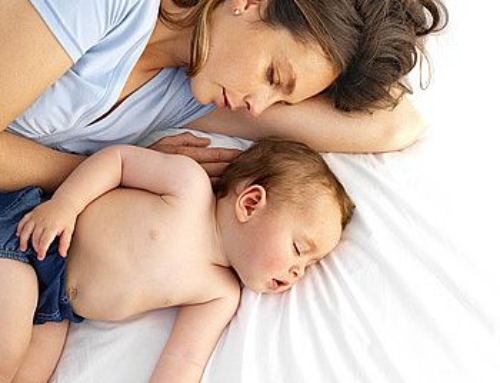Is it safe for your family to bedshare?
Although many people who bedshare believe most sleep problems new parents have would be lessened by bedsharing, for some it is just not a safe practice. There are lots of resources out there on safe bedsharing, including a pamphlet from us here at EP (see here). In short, there are some things that one should keep in mind if you are considering bedsharing.
You should not bedshare if you are a smoker, if you regularly use any medication or drugs that impair your ability to stay alert and focused (i.e., even cold medication should not be combined with bedsharing), or if you are overly tired (to the point where you are having troubles focusing). You should also never bedshare on a sofa or waterbed. In addition to this there are smaller things that affect bedsharing with younger infants that many parents don’t consider. For example, those sleeping on a soft mattress should not bedshare as infants can sink in and if they end up on their stomachs can suffocate as they are typically unable to move their heads. If you have lots of sheets and pillows on the bed that must be there for your sleep, it is not a safe environment for a young infant. Beds that are high also run the risk of having baby fall off, so the bed should ideally be as close to the ground as possible. Of course, as your child gets older, these risks become minimal, and thus some families start off room-sharing, with their infant in a bassinet or crib next to the adult bed and when the child outgrows that, they move into the family bed.
Are you comfortable bedsharing?
As much as I (and many other bedsharing parents) want everyone to feel the warmth and love that comes with bedsharing, we have to be honest that for some people, it’s going to be a subpar decision for their family. This lack of comfort can come in two ways. First, there’s the physical discomfort problem in that for some individuals it’s just not comfortable. This can include mom, dad, or baby. Now, when it’s dad who finds it uncomfortable, some families will have dad in one room and mom and baby in another, especially when mom is breastfeeding as bedsharing and breastfeeding really do go quite well together (see here). But sometimes it’s mom or baby who don’t sleep well next to each other and that’s okay. If you sleep worse or your baby sleeps worse when the two of you are together, then bedsharing isn’t for you. However, there is always room sharing, which allows easier access for breastfeeding, the closeness that humans crave with sleep, and is cuts the risk of SIDS in half relative to infants sleeping in their own room[3]. Room sharing can include a bassinet or crib next to the bed or even a separate mattress when the child is older.
The second type of discomfort is psychological. Unfortunately I think this stems primarily from our societal expectations and fear inducing messages telling parents that they will kill their child if they bedshare. These statements are misguided and fail to address the issue that bedsharing, like many other things, can be done safely, but it can also be done dangerously. Regardless of the cause, some parents feel overwhelming anxiety and fear at the idea of sharing a sleep space with their infant. If this is the case, then you should not bedshare, but instead look into room-sharing to keep your infant close to you without added stress and anxiety. In fact, some parents who start out room-sharing eventually feel comfortable enough to switch to bedsharing after a period of time. Sometimes all it takes is seeing how in tune you actually are with your baby and some research on how to safely bedshare for parents to make the switch.
One thing I want to mention is that in this fear, many parents express concern for their marital or romantic relationship. Let me reassure you that although having another person share the bed does change the manifestation of the relationship, if you put in the work, get creative, and are committed to each other, your relationship will be fine. In fact, there’s even research to support that. Marital relationships are not negatively influenced by bedsharing[4], so you need not worry.
What kind of sleeper are you?
One area that is rarely mentioned in the ‘to bedshare or not’ discussion has to do with the type of sleeper mom is. Let me explain. Thomas Anders and colleagues conducted an observational study to determine the sleep patterns of bedsharing and solitary sleeping infants[5]. Typically this has been looked at within infants, meaning that researchers will look at how one particular infant sleeps while bedsharing and then while sleeping alone. The problem is that an infant who is, for example, used to sleeping with mom is probably going to behave very differently than an infant who is used to sleeping without mom. What did they find? While bedsharing and solitary sleeping infants sleep the same duration, their night waking patterns were different. Specifically, bedsharing infants woke more frequently but for much shorter periods of time whereas solitary sleeping infants slept longer bouts but when they woke, were up for longer periods.
How does this matter to mom and dad? It depends on the type of sleeper you are. If you find it very difficult to get back to sleep regardless of how often you wake or the cause of waking, then you may find it better to have your infant room-share, but sleep on a solitary surface, allowing a greater likelihood of longer bouts before waking. And when your babe does wake, at least you’re on the same level of taking a while to get back to sleep. However, if you find you can wake and go back to sleep quickly, or especially if you can go to sleep quickly if given the chance to go to sleep quickly but might wake up more if you have to stay up, bedsharing may be better. Yes, there may be more frequent wakings, but they will be brief enough to allow you to return to sleep quickly. And if you’re breastfeeding, most moms eventually hit the stage where their infant can latch without much (or any) assistance, meaning you barely wake up when they nurse, providing longer stretches of sleep.
Conclusions
Most people who bedshare love it. It’s a wonderful way to provide our children with lots of touch, and for many working parents, it provides a level of contact that is difficult to obtain during the day. However, it’s also not for everyone. And you can be securely attached to your child without sharing a bed. Each family must consider their needs. Hopefully this can help you navigate towards the decision that is best for your family. But I do implore you… if you can’t bedshare or choose not to, please room share. We are social beings and that doesn’t end at sleep (see here), our infants do best when they are close to us, hearing us breathe, and feeling the sense of security at knowing they are being looked over and cared for. Not only that, but putting your infant in their own room doubles the risk of SIDS compared to having them in your room, so why even risk that?
Our goal as parents should be to make sleep a safe experience for our children, starting in infancy. Positive sleep associations will serve our children well for their entire lives. Humans have evolved to sleep in close proximity to each other for myriad reasons, and modern parenting practices should take note of this fact. Bedsharing isn’t for everyone, but keeping your child close? That should be.
[Gioia Albano (click for more beautiful images)]
[1] Diamond J. The World Until Yesterday: What Can We Learn From Traditional Societies? New York, NY: Viking (2012).
[2] Lozoff B, Wolf AW, Davis NS. Cosleeping in urban families with young children in the United States. Pediatrics 1984; 74: 171-182.
[3] Blair PS, Fleming PJ, Smith IJ et al. Babies sleeping with parents:case control study of factors influencing the risk of the sudden infant death syndrome. CESDI SUDI research group. British Medical Journal 1999; 319: 1457–1462.
[4] Messmer R, Miller LD, Yu CM. The relationship between parent-infant bed sharing and marital satisfaction for mothers of infants. Family Relations 2012; 61: 798-810.
[5] Mao A, Burnham MM, Goodlin-Jones BL, Gaylor EE, Anders TF. A comparison of the sleep-wake patterns of cosleeping and solitary sleeping infants. Child Psychiatry and Human Development 2004; 35: 95-105.







[…] my second son was born, we co slept and when he was done co sleeping, we moved him to a variety of sleeping apparatus (infant swing, pack and play, bassinet etc.) where […]
I absolutely love this! I’m glad a friend of mine sent me the link to this article 🙂 I tried bedsharing when my daughter was young. I quickly learned (by one month old) that it wasn’t for me. I simply spent the entire night awake b/c of every single movement or sound she made, woke me up. I also realized, my snoring and moving woke HER up! It was crazy and I moved her into a bassinet in the room. I FINALLY started getting sleep again. She is now 7yrs old and such a great sleeper (albeit she still wakes up at 6am every day hahaha, my morning baby).
I am very pro bedsharing. For those it works for <3 I've had many moms talk with me about feeling like they should stop b/c their child hit a certain age or because they're married, etc etc etc. I ask them a few simple questions: Does your husband mind? Does it bother you still sharing a bed? Do you all sleep well? Are you happy? If they answer no to the first two, and yes to the second two, I tell them they have their answer then. It's definitely something I always suggest new moms look into, even if I know it doesn't work for me! Trial and error <3
Thanks so much for this article – I also tried to bed share with my first baby and all of us were such light sleepers – myself, my partner and Bub that no-one got any sleep! we moved him to a bassinet in the room and it worked much better however I always felt a bit sad that I wasnt able to sleep with him – to this day he is the same a very light sleeper and cant handle having anyone in his space – my independent one! My 2nd son was very different and I actually found that sleeping with him in my bed at times worked beautifully for us – sadly not full time as my partner still gets kicked in the back constantly and sleeping in another room was of no interest to him or me really either but he also slept in our room at different times and close to us. We have number 3 on the way so it will be interesting to see what this babe holds for us! This article really helps look at things from a practical perspective and helped me feel much more normal!!! – thank you so much!
You’re welcome! I’m glad you were able to find solutions that worked for you all (to a degree) that took your individual children into account 🙂 Congrats and good luck with number 3!
This is my current solution because going back and forth to the baby room is tiring!